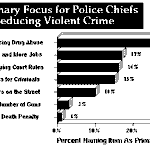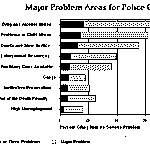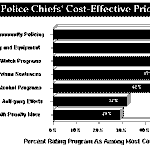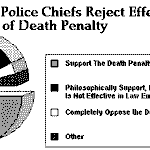On the Front Line: Law Enforcement Views on the Death Penalty
Posted on Feb 01, 1995
- Introduction
- Law Enforcement Perspectives on Fighting Crime: A National Poll of Police Chiefs in the U.S.
- Police Views on Crime Prevention
- Cost-Effective Crime Prevention: Spending Priorities for Police
- Community Policing: Experience Supports Chiefs' Priorities
- Gun Control
- Support for the Death Penalty in Theory and in Practice
- Law Enforcement Organizations' Proposals for Fighting Crime
- Conclusion
- Statement on Law Enforcement and the Death Penalty
“I think that the only purpose for the death penalty, as I see it, is vengeance – pure and simple vengeance. But I think vengeance is a very personal feeling and I don’t think it is something that civilized government should engage in .…”
“The death penalty does little to prevent crime. It’s the fear of apprehension and the likely prospect of swift and certain punishment that provides the largest deterrent to crime.”
“Take it from someone who has spent a career in Federal and state law enforcement, enacting the death penalty … would be a grave mistake. Prosecutors must reveal the dirty little secret they too often share only among themselves: The death penalty actually hinders the fight against crime.”
“I am not convinced that capital punishment, in and of itself, is a deterrent to crime because most people do not think about the death penalty before they commit a violent or capital crime.”
Introduction Top
A new national survey of police chiefs from around the country discredits the repeated assertion that the death penalty is an important law enforcement tool. While politicians have extolled the importance of capital punishment in fighting crime, they have failed to assess the actual priorities of those in law enforcement and have saddled the taxpayers with an enormously costly death penalty at the expense of more effective crime fighting strategies.
In January, 1995, Peter D. Hart Research Associates conducted a national opinion poll of randomly selected police chiefs in the United States. In that poll, the chiefs had the opportunity to express what they believe really works in fighting crime. They were asked where the death penalty fit in their priorities as leaders in the law enforcement field. What the police chiefs had to say may be surprising to many lawmakers, and to much of the public as well. The Hart Poll found that:
- Police chiefs rank the death penalty last as a way of reducing violent crime, placing it behind curbing drug abuse, more police officers on the streets, lowering the technical barriers to prosecution, longer sentences, and a better economy with more jobs.
- The death penalty was rated as the least cost-effective method for controlling crime.
- Insufficient use of the death penalty is not considered a major problem by the majority of police chiefs.
- Strengthening families and neighborhoods, punishing criminals swiftly and surely, controlling illegal drugs, and gun control are considered much more important than the death penalty.
- Although a majority of the police chiefs support the death penalty in the abstract, when given a choice between the sentence of life without parole plus restitution versus the death penalty, barely half of the chiefssupport capital punishment.
- Police chiefs do not believe that the death penalty significantly reduces the number of homicides.
- Police chiefs do not believe that murderers think about the range of possible punishments.
- Debates about the death penalty distract Congress and state legislatures from focusing on real solutions to crime.
In sum, while many police chiefs support the death penalty philosophically, a strong majority do not believe that it is an effective law enforcement tool in practice. In the report below, the various findings of this poll will be explored in depth, along with a broader analysis of what really works in reducing crime. The results of this opinion poll are confirmed by the statements of individual leaders in the law enforcement community, by research in the field of criminology, and by the recommendations of many of the nation’s leading law enforcement agencies.
Law Enforcement Perspectives on Fighting Crime: A National Poll of Police Chiefs in the U.S. Top
In 1994, crime was the nation’s number one concern. Despite political gridlock on many other issues, President Clinton was able to move a $30 billion crime bill through Congress, including a major expansion of the federal death penalty. The elections in November produced a cascade of candidates tripping over each other to sound even tougher than their opponent on crime. Campaign advertisements reached new lows in mongering fear in the electorate in order to boost the chances of “law and order” politicians. Candidates used the death penalty as a club, even against those who supported it.
But few, if any, politicians took the time to ask those in law enforcement what they thought would really work in preventing crime. Was the death penalty, in fact, the top priority for law enforcement that it was for the politicians?
Police Views on Crime Prevention Top
Law enforcement officers are society’s front line in fighting crime. They see it up close every day, and they have a personal stake in reducing violence. So, it is natural to ask them: “What, in your opinion, works in the battle against crime?”
This question was approached from a variety of directions. Police were first given an open-ended opportunity to state the areas that would have the biggest impact on reducing violent crime in their jurisdiction. Sentencing reform, including truth in sentencing, elimination of parole and stiffer sentences was the most often cited area of reform (33% of respondents). Other areas of emphasis included the development of family values and parenting skills (23%), education (15%), and more police (13%). The death penalty was mentioned by fewer than 2% of the chiefs and followed twenty-five other areas of concern.
The police chiefs were also asked to select their primary choices from a list of possible ways to reduce violent crime. The need to reduce the prevalence of drug abuse was their first priority. They also chose longer prison sentences for criminals, fewer technical legal barriers to the prosecution of criminals, more police officers on the street, a better economy with more jobs, and reducing the number of guns over an expanded use of the death penalty as better ways to lower crime. Capital punishment ranked a distant last, with only 1% of the chiefs citing it as their primary focus for stopping violent crime. These results are illustrated in Figure 1 below.
In a similar vein, the poll explored what the police chiefs see as the main obstacles to their success as they try to protect citizens and fashion a safer society. Again, drug and alcohol abuse surfaced as the most frequently mentioned problem facing police forces today. Fully 87% chose this as a serious problem (i.e., “top two or three problems” or as a “major problem”) which they encounter in their work. Family problems or child abuse was the second major obstacle for police, with 77% citing this as a serious problem in their jurisdiction.
The police chiefs were evenly split between those stating that a lack of law enforcement resources was a serious problem (49%) and those who thought it was at most a minor problem (50%). About 45% of the police chiefs stated that the availability of too many guns was a serious problem. Interestingly, most of the chiefs did not see gangs as a major problem in their efforts. Only 7% reported that gangs were one of their top two or three problems.
Other areas which were cited as major problems included crowded courts and slow justice. On the other hand, ineffective prosecution and high unemployment were only rated as minor problems. Again, the death penalty ranked near the bottom as a serious concern for law enforcement officers.
Insufficient use of the death penalty was rated as either a minor problem or no problem at all by 63% of the respondents. (See Figure 2).


Cost-Effective Crime Prevention: Spending Priorities for Police Top
No one is more keenly aware of the fact that preventing crime costs money than police chiefs. Faced daily with budget decisions and the rising costs of salaries, training and equipment for a police force, chiefs must constantly balance emergency responses and long-term needs. The Hart Poll sought to discover not only what police chiefs ideally want in the fight against crime, but also what are the most cost-effective methods available to them.
Among strategies used for controlling crime, the death penalty ranked last in terms of its cost-effectiveness. The related areas of community policing and expanded training with more equipment for police, received the highest cost-effective ratings by the police chiefs among ways to reduce crime. Fifty-six percent of the respondents rated these areas as cost-effective (i.e., they gave it an 8, 9, or 10 out of a possible 10). Imposing the death penalty more often was thought to be cost-effective by only 29% of the chiefs. Neighborhood watch programs ranked almost as high as community policing in terms of effectiveness for the dollars spent. The chart below (Figure 3) illustrates the relative cost effectiveness which the police gave to these various measures.
Reliable estimates indicate that the cost of the death penalty to taxpayers is over $2 million per execution, with the bulk of the costs occurring at the trial level. [5] That figure is a measure of the extra costs attributable solely to capital punishment, beyond the costs of a typical murder case without the death penalty and the costs of incarceration resulting from a life sentence.
There are increasing demands for the limited crime fighting resources. Many states and counties are strapped for funds and are facing severe budget crises. Hard choices have to be made among various strategies for fighting crime. If $2 million is spent on the death penalty, then that same money is not available for more police officers, or for bullet proof vests, or for speedier trials, or neighborhood watch programs, or community policing.
“It currently costs three times as much — more than $2 million per inmate — to carry out the death sentence than to keep an inmate in prison for 40 years. In other words, it’s cheaper to lock ‘em up and throw away the key.… it’s something to consider.”–Former Texas Attorney General, Jim Mattox [6]
The average salary for a new police officer is about $42,000 per year, including benefits. [7] Thus, $2 million translates into approximately 48 additional police officers, a far more likely and immediate deterrent to crime than one remote execution. Similarly, the same $2 million could buy thousands of bullet-proof vests, or provide improved lighting in high-crime areas, or could be used as seed money for neighborhood watch programs.

Community Policing: Experience Supports Chiefs’ Priorities Top
One of the principal reasons that those in law enforcement are not enamored of the death penalty is that they do not believe it is a deterrent to crime. Law enforcement officers believe that the most effective deterrent to crime is swift and sure punishment. When asked which societal or legal changes would have the greatest impact on reducing violent crime, police chose strengthening families and neighborhoods, along with swift and sure punishment for offenders, as the means that would bring about the most significant effects.
Police wanted more control over illicit drugs, greater latitude for judges in criminal cases, greater economic opportunity, and a reduction in the number of guns in circulation. Expanding the death penalty, on the other hand, was not thought to have a big impact on crime reduction.
Over two-thirds of the police chiefs did not believe that the death penalty significantly reduces the number of homicides. About 67% said that it was not one of the most important law enforcement tools. And well over 80% of the respondents believe that murderers do not think about the range of possible punishments before committing homicide. The figures below (Figs. 4.1 – 4.3) illustrate the lack of confidence which police chiefs place in the death penalty as a deterrent.
One of the many problems with the death penalty is that it is anything but swift and sure. Even under current proposals for restricting death penalty appeals, the sentence would be carried out years after it is imposed, on relatively few of all the convicted murderers, and with a substantial likelihood that the sentence will be overturned before the execution is carried out. Sentences of life without parole, in contrast, begin immediately upon sentencing and are rarely overturned on appeal.
Capital cases are a nightmare for the entire justice system. Police chiefs recognize that death penalty cases are particularly burdensome in the early stages. Two-thirds of the police chiefs polled said that death penalty cases are hard to close and take up a lot of police time.
Jim Mattox, former Attorney General of Texas, who supported the death penalty during his term of office and oversaw many of the state’s first executions after the death penalty was reinstated, does not believe that murderers in Texas are deterred by the death penalty. Mattox interviewed nearly all the people executed in Texas between 1976 and 1988 and concluded that the sentence of death never crossed their minds before their crime[15]: “It is my own experience that those executed in Texas were not deterred by the existence of the death penalty,” he said. “I think in most cases you’ll find that the murder was committed under severe drug and alcohol abuse.” [16]
Lieutenant Gregory Ruff, a police officer in Kansas for 23 years, agrees: “I have seen the ugliness of murder up close and personal. But I have never heard a murder suspect say they thought about the death penalty as a consequence of their actions prior to committing their crimes.”[17]
“I have seen the ugliness of murder up close and personal. But I have never heard a murder suspect say they thought about the death penalty as a consequence of their actions prior to committing their crimes.”–Police Lieut. Gregory Ruff, Kansas
Willie Williams, Chief of Police in Los Angeles, echoed the same theme from his years of experience: “I am not convinced that capital punishment, in and of itself, is a deterrent to crime because most people do not think about the death penalty before they commit a violent or capital crime.”[18]
Youth and the Culture of Violence
Another reason why the death penalty fails as a law enforcement tool is that one of the most violent segments of the population is the least likely to be deterred by prospective punishments. Many who might face the death penalty live in a culture of violence. The leading cause of death among young black men, for example, is murder. [19] They are more likely to be killed by a rival gang member or by a drug dealer whom they double-crossed than by the state. James Fox, dean of the College of Criminal Justice at Northeastern University, has noted the fast growth in violent crime among teenagers: “Many of them face death every day of their lives. They don’t think about the possibility — as remote as it is — that they’ll someday die for a crime. These kids are all armed and in gangs, and they worry about dying next week.” [20] In such an environment, the threat of the death penalty adds little to the danger.
The Hart survey showed that police chiefs are very much aware of the problems among youth today. Strengthening families, neighborhoods and churches were among their top priorities throughout the poll. In the open-ended question about changes which would most likely reduce violent crime, police mentioned concerns about the needs of young people and juvenile offenders ahead of a desire for more police or financial resources.
Richard H. Girgenti, the New York State Director of Criminal Justice, noted that “[d]emographics have always been the best predictor of future crime.”[21] In preparing for challenges in combating crime in the next decade, it is sobering to note that murders by those between the ages of 14 to 17 grew by 124% between 1986 and 1991, while murder among adults 25 and over actually declined. [22] Since many teenagers are not even legally eligible for the death penalty, much less deterred by it, and since the number of teenagers in the population will be growing tremendously in the next 10 years, more creative approaches to preventing violent crime are essential.
Deterrence of Police Killings
Even when it comes to the killing of a police officer, the death penalty is not a deterrent. Texas, by far the leading death penalty state, for the past six years has also been the leading state in the number of its police officers killed. By comparison, last year New York, with no death penalty, had about one third as many officers killed as Texas. [23]
A recent study of the deterrence value of the death penalty published in the Journal of Social Issues surveyed a 13-year period of police homicides. The researchers concluded: “[W]e find no consistent evidence that capital punishment influenced police killings during the 1976 – 1989 period.… [P]olice do not appear to have been afforded an added measure of protection against homicide by capital punishment.” [24]



Gun Control Top
In a nation with over 200 million firearms, gun control is also a priority among many law enforcement agencies. About 45% of police chiefs listed the easy availability of guns as a major problem in fighting crime, though only 38% thought that reducing the number of guns would have a big impact on crime. The International Association of Chiefs of Police, the largest such organization in the world, called for strict control of certain weapons: “The deadly flow of military assault-type automatic and semi-automatic weapons onto the streets of America and into the hands of violent criminals means that all too frequently the superior firepower belongs to the criminals, not law enforce-ment.” [25] They called for a complete ban: “Manufacture and sale of assault weapons to the general public should be prohibited.” [26] Other police organizations have also supported tighter gun controls.[27]
“Many politicians say the death penalty would help us in New York by deterring would-be killers. I believe it would make things worse because it is another instruction in brutality.… From 1983 to 1992, states that resumed executions averaged three times as many police officers killed than have been killed in New York. How can anyone pretend that capital punishment will make us safer?”
–Thomas A. Coughlin III, Former Commissioner, New York State Dept. of Correctional Services [28]
While the public is deeply concerned about violent crime, it is really gun-related crime that has shown the most dramatic increases. According to the FBI, the violent crime rate has actually decreased over the past decade, but crimes with handguns have grown disturbingly. From 1987 to 1992, handgun crimes rose 55 percent. [29]
A comparison of handgun deaths in the United States as contrasted with other countries demonstrates how serious a problem guns are. In 1992, the United States suffered 13,220 murders by handguns. By comparison, there were only 128 such deaths in Canada, 60 in Japan, only 33 in Great Britain, and just 13 in Australia. [30] Some experts in European countries attribute their lower murder rates to stricter gun controls.[31]
“We may have put the caboose on the front — we should have gone after guns first.… Decent folk are just tired of living under the threat of the gun.”–James D. Toler, Chief of Police, Kansas City, Missouri[32]
A recent profile of the criminal justice systems in the United States and England published by the U.S. Department of Justice highlighted other interesting differences between these two countries. Violent crime was significantly higher in the U.S., with the homicide rate in the U.S. being almost seven times that in England and Wales. England and Wales employed proportionately more law enforcement officers (256 per 100,000 population) than did the U.S. (240 officers per 100,000 population), and spent more per resident on their justice system than did the U.S. [33] None of that spending went toward the death penalty, which has been abolished in the United Kingdom.
Support for the Death Penalty in Theory and in Practice Top
A clear majority of the police chiefs in the Hart Poll say that capital punishment is not an effective law enforcement tool, even though they support it philosophically. The chiefs were asked which of three statements came closest to their own point of view:
- I support the death penalty and think it works well.
- Philosophically, I support the death penalty, but I don’t think it is an effective law enforcement tool in practice.
- I oppose the death penalty.
About a third of the respondents approved of the death penalty in practice. On the other hand, 58% of the police chiefs, while supporting the death penalty philosophically, did not think it was an effective law enforcement tool. When combined with the percentage who opposed capital punishment completely, this result corresponded well with the two-thirds of police chiefs who disagreed that the death penalty significantly reduces the number of homicides and the equal number who say that murderers do not think about the range of punishments before committing homicides. (See Figure 5).
Police chiefs recognize that the death penalty has been over-used by politicians. Ronald Hampton, President of the National Black Police Association in Washington, DC, noted: “[The death penalty] is a political move, insensitive to the real needs of the people in this city.” [34] Eighty-five percent of the chiefs polled believed that politicians support the death penalty as a symbolic way to show they are tough on crime. In line with their belief that capital punishment is not an important law enforcement tool, the majority of police chiefs believed that time spent on capital punishment in Congress and in state legislatures distracts from finding real solutions to the problems of crime.
Similar to the results of recent opinion polls showing the public’s openness to death penalty alternatives, [35] the Hart poll showed that police chiefs believe in harsh punishment for those who commit murder, though, not necessarily, the death penalty. When offered the alternative sentence of life imprisonment with no possibility of parole, combined with mandatory restitution to the victim’s family, support for the death penalty among police chiefs drops to only 50%. And among the majority of police chiefs who do not believe the death penalty is effective in practice, 52% would prefer the alternative sentence over capital punishment.

Law Enforcement Organizations’ Proposals for Fighting Crime Top
Many organizations in the United States are committed to law enforcement and to finding solutions to the problems of crime and violence. In grappling with these issues, a number of these organizations have produced statements and studies on what can be done to reduce crime. The proposed solutions range from a fundamental restructuring of society to more immediate innovations that citizens can implement in their own neighborhoods. Rarely is the death penalty even mentioned in their discussions. Instead, the solutions are changes and programs that affect a broad range of people and go to the roots of why violent crime has become so prevalent.
Because the root causes of violence are so deeply entrenched and so difficult to change, the death penalty presents a tempting “quick fix” to a complex problem. Nevertheless, many law enforcement groups have taken crime head-on and have proposed a variety of practical remedies.
In A National Action Plan to Combat Violent Crime, police chiefs from Atlanta, Boston, Louisville, Knoxville, Salt Lake City, Chicago, and Washington, DC, along with the U.S. Conference of Mayors, teamed together in 1993 to address the crime emergency and to make recommendations to the President of the United States. Their crime fighting priorities reflect many of the same concerns which were voiced by police chiefs all over the country in the Hart Poll:
1. Funds for additional police officers, and the implementation of community policing, with no cut in other programs that address urban needs and the root causes of crime.
2. Omnibus firearm control measures, including:
- Banning the manufacture, sale and possession of all semi-automatic assault weapons and their component parts.
- Registration of all newly purchased and transferred firearms
- Expansion of the Brady Law to all firearms sales.
- Liability of gun dealers for damages resulting from illegal sales.
3. Expanded drug control efforts, including:
- Expansion of treatment programs so that services are available to all in need
- Mandatory minimum sentences for all repeat drug sale convictions
- Establishment of additional drug courts
4. Restructuring and strengthening the criminal justice system, including:
- Emphasis on juvenile crime; greater prosecution of violent juvenile offenders as adults.
- Expansion of number of prosecutors, court services and personnel
- Expansion of boot camps and other alternatives to prisons
5. Long term crime reduction strategy:
- Reduce unemployment
- Community involvement in preventing crime
- Focus on young people: addressing family violence, jobs, preventing school dropouts
- Expansion of violence reduction and conflict resolution programs
6. Partnerships to prevent violent crime:
- More coordination of efforts among mayors, police chiefs and the federal leaders
- Improved sharing of intelligence and technologies
- Involvement of schools, public health departments, human service agencies, businesses and neighborhood organizations in crime prevention
- Confronting the entertainment industry on the proliferation of violence.[36]
The International Association of Chiefs of Police (IACP) also issued a series of recommendations in 1993 in response to the problem of violent crime in America. The IACP convened a summit of police executives from around the country. Participants included representatives of the Bureau of Alcohol, Tobacco, and Firearms, the Federal Bureau of Investigation, the Immigration and Naturalization Service, and the Drug Enforcement Administration, as well as police chiefs from major cities. Following the summit, the IACP made a series of recommendations, including:
- Declaration of a National Commitment to address violent crime, including the establishment of a Presidential Commission on Crime and Violence.
- Restrictions on firearms purchases, limiting sale and manufacture of automatic and semi-automatic assault weapons.
- Fighting drugs through educational programs, interdiction and detection programs, and incarceration of violent and non-violent offenders.
- Combating the influence of gangs by gathering intelligence, enacting new laws directed at illegal gang activity, enacting juvenile justice reforms, and encouraging multi-jurisdictional cooperation. [37]
Many of the nation’s largest law enforcement organizations supported the crime prevention measures in the recent federal crime bill. When these measures came under attack following the political shifts in the recent elections, the 250,000 member Fraternal Order of Police (FOP) issued a statement strongly opposing efforts to the remove the new law’s resources and crime prevention programs: “Crime problems require law enforcement and social remedies,” said Richard Boyd, Director of Member Services for the National FOP.[38]
One law enforcement group representing more than 35,000 individual members, the National Black Police Association, has a specific policy against the death penalty. Instead, they emphasize programs that control drugs, handgun control, and community policing to combat the problems of crime.[39]
Other law enforcement organizations, such as The Police Foundation and The Police Executive Research Forum, are focused primarily on research. They explore topics and produce publications on such topics as community policing, the effects of drugs on crime, and a host of issues of concern to those in law enforcement. Again, the death penalty is not one of their areas of concern.[40]
Police chiefs are not alone in their strong reservations about the effectiveness of the death penalty. Robert Morgenthau, Manhattan’s District Attorney for the past twenty years, recently said that the failure of the death penalty is actually a well kept secret among many prosecutors as well: “Prosecutors,” he wrote in The New York Times, “must reveal the dirty little secret they too often share only among themselves: The death penalty actually hinders the fight against crime.” [41]
“The death penalty actually hinders the fight against crime.”–Robert M. Morgenthau, Manhattan District Attorney
Increasingly, crime prevention is a question of resources. “Executions,” said Morgenthau, “waste scarce law-enforcement financial and personnel resources.”[42]
Conclusion Top
Police chiefs and law enforcement organizations are deeply concerned about solutions to the crime problem facing this country. They come to this crisis with years of experience on the front line of doing whatever is in their power to reduce crime. They support those programs that will have a clear impact. Community policing, neighborhood crime programs, gun control, and a focused approach to certain kinds of crime, such as drug crime and youth crime, are among the approaches they recommend most strongly. They are equally clear that the problem of violence is not one which can be left to law enforcement to solve. Stronger families and neighborhoods, intervention on behalf of youth, and a sound economy with sufficient jobs are all necessary steps to a safer society.
Police chiefs are demonstrably less supportive of solutions like the death penalty, which merely sound tough but produce little return for the large amount of money invested. Some in law enforcement are totally opposed to capital punishment; others support it in theory. But few would give it the high priority accorded it in political campaigns and in legislative agendas designed mostly for sound bites and quick fixes.
Methodology of the Hart Poll
A total of 386 daytime telephone interviews were conducted with randomly designated police chiefs and county sheriffs throughout the U.S., excluding Alaska and Hawaii between January 17 and 24, 1995. The margin of error is no more than +6 percentage points with a 95% confidence level.
Statement on Law Enforcement and the Death Penalty Top
A number of individuals who have been leaders in the law enforcement community have begun speaking out about the over-emphasis the death penalty has received from politicians campaigning for office. These officers and former officers agree that crime is a critical problem in America, but they do not see capital punishment as a likely solution. Regardless of their individual views on the acceptability of the death penalty, they do not consider it to be a strong deterrent to crime and believe that other, more effective crime prevention measures should be given priority.
A statement regarding law enforcement and capital punishment, along with the endorsers of that statement, is included below as an indication of the position of a growing number of members of the law enforcement community:
Law Enforcement Statement on Capital Punishment
As law enforcement officers, our primary concern is the protection of the public from crime. Punishment of offenders is a crucial element of this protection, and one which we believe is vitally important in deterring crime.
Recently, attention has focused on one form of punishment: the death penalty. As individuals, we differ widely in our belief in capital punishment. Many of us hold that the death penalty, if fairly and equitably administered, may have a role in American society. Others of us have sincere reservations about the use of this ultimate sanction.
As endorsers of this Statement, however, we share the belief that other law enforcement priorities are far more important and urgent than capital punishment. The death penalty absorbs an inordinate portion of the financial resources and valuable time of the criminal justice system. Because millions of dollars and countless hours of court time go toward the execution of a single individual, we believe that other dimensions of crime prevention are being short-changed.
In many communities, the public would be better served by measures such as the hiring of additional police officers, the implementation of community policing, drug interdiction programs, early childhood intervention programs, weapons control programs, speedier trials, or better funded probation and parole departments, than by an occasional death sentence on an isolated individual, to be carried out, if at all, only many years later. The death penalty may fascinate the media and the public, but it is truly peripheral to our efforts to make this society safer.
Too much attention on one extreme of law enforcement distracts the public from the more critical task of combating daily crime on our city’s streets. State and federal legislatures spend an exorbitant amount of time debating the merits of the death penalty. The courts are burdened with lengthy death penalty trials and years of appeals. From the perspective of those of us who see crime up close on a daily basis, there are far higher priorities that deserve the public’s attention and support.
We deeply understand the public’s concern with the amount of random, violent crime prevalent in our society today. The solutions to this problem are not easy ones, and they require a commitment of money and resources. The sooner we order our crime prevention priorities toward solutions with proven records of effectiveness, the sooner we will be able to make a serious dent in America’s crime problem.
ENDORSEMENTS
(List in formation)
Catherine M. Abate
Former Commissioner
New York City Dept. of Correction*
Gordon S. Bates
Executive Director, Connecticut Prison Association*
Donald A. Cabana
Former Warden and Commissioner of
Corrections, Mississippi*
Jo Ann D. Diamos
Former U.S. Attorney, Arizona*
Walter J. Dickey
Former Commissioner,
Wisconsin Dept. of Corrections*
Jerry J. Enomoto
Former Director,
California Dept. of Corrections*
James J. Fyfe
Former Lieutenant
New York City Police Dept.*
James M. Gamble
Administrator, Montana Dept. of Corrections *
Robert Gangi
Executive Director, Correctional Association of New York*
Patricia L. Gatling
Former President,
National Black Prosecutors Association*
John F. Gorczyk
Commissioner,
Vermont Dept. of Corrections*
Ronald E. Hampton
Director, National Black Police Association*
Thomas L. Johnson
Former Hennepin County Attorney, Minnesota*
John R. Kramer
Executive Director, Pennsylvania Commission on Sentencing*
Jennie Lancaster
Female Command Manager
North Carolina Dept. of Prisons*
William M. Leech, Jr.
Former Attorney General, Tennessee*
Sidney I. Lezak
Former U.S. Attorney, Oregon*
Elaine Little
Director, North Dakota Department of Corrections*
Terre K. Marshall
Deputy Commissioner
Connecticut Dept. of Corrections*
George N. Martin III
Regional Administrator
Former Warden
South Carolina Dept. of Corrections*
E. Michael McCann
District Attorney
Milwaukee, Wisconsin*
Patrick C. McManus
Former Secretary of Corrections, Kansas*
F. Russell Millin
Former U.S. Attorney,
Western District of Missouri*
Kathryn R. Monaco
Former Deputy Sec. for Correction, New Mexico*
Patrick V. Murphy
Former Police Commissioner New York, NY; Detroit, MI
Former Public Safety Director, Washington, DC*
Robert P. Owens
Former Chief of Police
Oxnard, California*
Orville B. Pung
Former Commissioner,
Minnesota Department of Corrections*
W. Jeff Reynolds
Former Commissioner,
Tennessee Dept. of Corrections*
Chase Riveland
Secretary, Washington Dept. of Corrections*
Larry D. Smith
Deputy Assistant Secretary of Corrections, Louisiana*
Raoul Stitt
Assistant Prosecuting Attorney,
Jackson County, Missouri*
Myra Wall
Assistant to the Secretary, Department of Corrections, Washington*
* Law Enforcement affiliation listed for identification only
[1]. Remarks at the National Press Club, July 1, 1993.
[2]. Press release, Death Penalty Information Center, Oct. 27, 1992.
[3]. R. Morgenthau, What Prosecutors Won’t Tell You, The New York Times, Feb. 7, 1995, at A25.
[4]. R. Abramson, Emphasis on Values Is Needed to Stem Crime, Williams Says, The Los Angeles Times, April 27, 1992, at B1, 4.
[5]. See P. Cook & D. Slawson, The Costs of Processing Murder Cases in North Carolina 97, 98 (May, 1993).
[6]. J. Mattox, Texas’ Death Penalty Dilemma, The Dallas Morning News, Aug. 25, 1993.
[7]. Violent Crime Control and Law Enforcement Act of 1994: Briefing Book, U.S. Dept. of Justice, Sept. 24, 1994.
[8]. C. Krauss, A Safer, if Not Safe, City: Crime Falls in New York, The New York Times, Jan. 1, 1995, at 1.
[9]. See T. Squitieri, Murder Rate is Up in Usually Slow First Quarter, USA Today, April 3, 1992, at 8A.
[10]. “Staggering” Crime Rate Drops: Cities Point to Police Strategies Behind the Decrease, Law Enforcement News, Jan. 15, 1994, at 1.
[11]. Id.
[12]. E. Meyer, Policing With People in Mind, The Washington Post, June 15, 1992, at A1, 8.
[13]. G. James, Having to Sell an Old Idea: the Cop on the Beat, The New York Times, Oct. 9, 1991, at B1.
[14]. ‘Attaboy’ for Community Policing: Two-state Survey Finds Strong Faith in New Approach, Law Enforcement News, Sept. 15, 1994, at 1.
[15]. T. Rohrlich, Does Death Penalty Deter Killers? No Clear Answer, The Los Angeles Times, Mar. 23, 1990, at A1, 26.
[16]. R. Dugger, In the Dead of the Night, The Texas Observer, April 22, 1988, at 7.
[17]. Testimony of Gregory Ruff before the Kansas Senate, Committee on State and Federal Affairs, Feb. 18, 1994, on file with the Death Penalty Information Center.
[18]. See note 4.
[19]. Crime in the United States, 1993, U.S. Dept. of Justice, at p. 283 (Dec., 1994).
[20]. N. Gibbs, Laying Down the Law, TIME Magazine, Aug. 23, 1993, at 23, 25.
[21]. C. Krauss, No Crystal Ball Needed on Crime, The New York Times, Nov. 13, 1994 (projecting large increases in the 15-to-19 year old population in the next 10 years).
[22]. See N. Gibbs, note 20.
[23]. Line-of-Duty Deaths Continue Their Upward Trend in the ’90s, Law Enforcement News, Jan. 15, 1994.
[24]. W. Bailey & R. Peterson, Murder, Capital Punishment, and Deterrence: A Review of the Evidence and an Examination of Police Killings, 50 Journal of Social Issues 53, 71 (1994).
[25]. Violent Crime in America: Recommendations of the IACP Summit on Violent Crime, The International Association of Chiefs of Police, April 27, 1993, at p.5.
[26]. Id.
[27]. See, e.g., statements by the National Association of Police Organizations (NAPO) in support of the gun control measures in the Violent Crime Control and Law Enforcement Act of 1994. Robert Scully, executive director of NAPO, speaking in praise of the Act, said: “[T]he American public wanted something done with guns. Despite all of the time, effort and money that was spent by the NRA, the American public was wise enough to see through it and still demanded that something be done about guns.” Law Enforcement News, Dec. 31, 1994, at 1, 15. For a list of other police organizations supporting this law, see id. at 14.
[28]. Executions: The Brutal Facts, The New York Daily News, Oct. 12, 1994.
[29]. Criminal Use of Guns Increasing, Government Says, The Dallas Morning News, Feb. 27, 1994, at 5A.
[30]. B. Herbert, Deadly Data on Handguns, The New York Times, Mar. 2, 1994.
[31]. See J. Socolovsky, European Countries Attribute Low Murder Rate to Gun Laws, The Gainesville (Fla.) Sun, May 19, 1991, at 1G.
[32]. F. Butterfield, Cities Finding a New Policy Limits Guns, The New York Times, Nov. 20, 1994, at 22.
[33]. Profile of Inmates in the United States and in England and Wales, 1991, U.S. Dept. of Justice, at p.2 (Oct., 1994).
[34]. See note 2 (quoting Ronald Hampton).
[35]. See, e.g., Sentencing for Life: Americans Embrace Alternatives to the Death Penalty, Death Penalty Information Center (1993) (national poll shows more Americans support life without parole plus restitution than the death penalty).
[36]. A National Action Plan to Combat Violent Crime: Recommendations of Mayors and Police Chiefs to the President of the United States, The U.S. Conference of Mayors, Dec. 9, 1993, at p.1 – 6.
[37]. See note 25 (Executive Overview).
[38]. Police ‘Oppose’ Sniping at the Crime Bill, electronic press release, Fraternal Order of Police, Sept. 27, 1994 (emphasis added).
[39]. Statements and resolutions of the National Black Police Association, Washington, DC, on file with the Death Penalty Information Center.
[40]. See recent publication lists of The Police Foundation and The Police Executive Research Forum, Washington, DC, on file with the Death Penalty Information Center (no mention of capital punishment in publication topics).
[41]. See note 3.
[42]. Id.